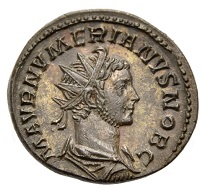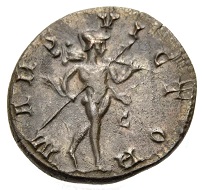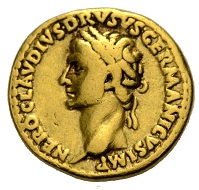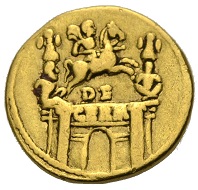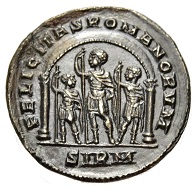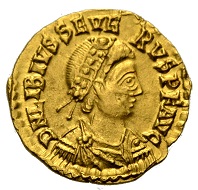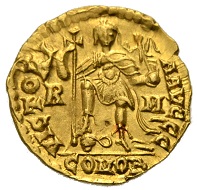08-06-2017 – 01-01-1970
Auction 45
Roman Coins from the Collection of Markus R. Weder
Auction 45 to be held by Münzen & Medaillen GmbH in their home town of Weil am Rhein will be devoted exclusively to ancient coins. Many of these originate from the collection amassed by Markus Robert Weder (1953-2016) focusing on late Roman Imperial coins.
The forthcoming auction to be held by Münzen & Medaillen GmbH in their home town of Weil am Rhein will be devoted exclusively to ancient coins. Many of these originate from the collection amassed by Markus Robert Weder (1953-2016), renowned specialist for Roman numismatics and particularly for coins of the 3rd Century A.D. and the Gallic Empire who worked in the British Museum for a time and was also active in the Swiss coin trade (with Leu Numismatics), as well as cataloguing coin finds: correspondingly, many coins in the auction were minted during this period and include some interesting rarities.
Lot 82: Roman Coins. Empire. Numerianus, 283-284. As Caesar under Carinus. Aurelianus, Lugdunum, 283. Good extremely fine. Estimate: 90 EUR.
The first 141 numbers in the auction form a section in memory of Markus Weder and encapsulate key areas of his collecting interests. Weder’s Greek coin collection included many specimens from Magna Graecia and ancient Italy. Rarities include bronzes from Hyrium, Caelia and other cities in Apulia, and a selection of coins of the Brettii. In addition he collected coins from the Jewish uprising under Shimon Bar Kochba in 132-135 and Ptolemaic bronzes from the collection of M. Jungfleisch. Among the Roman coins are a bronze of C. Clovius minted under Julius Caesar and Roman imperial coins from the collections of C. Herrenschmidt and of Prince Napoleon and the doublets of the British Museum, which Markus Weder was able to obtain during his years in London.
Lot 625: Roman Coins. Empire. Claudius, 41-54. Aureus, 41-45 for Drusus, on his victories in Germania. Very fine. Estimate: 1,000 EUR.
Markus Weder’s Roman coin collection encompassed the beginning of Roman coinage (and the pre-Roman coinage of Italy) up to its decline and fragmentation into local economic systems. Many coins are included as evidence for particular denominations: the small anonymous silver sestertii of the Roman Republic, marked IIS for Semis tertius, (=2 ½ Asses), which later gave way to the better known and larger bronze Sestertii of the later period, for example, and quinarii and quadrantes from the Republican and early imperial periods, including quadrantes issued under Nero and later emperors up to Trajan from the collection of Virgil P. Brand.
Lot 119: Roman Coins. Empire. Constantinus II. Caesar, 317-337. Miliarense, Sirmium, donativum. Small edge damage repaired, otherwise extremely fine. Estimate: 1,200 EUR.
Among the coins of the 3rd century are a number minted for the legionaries in Milan, where Roman armies were strategically stationed so as to have easy access to the troubled regions in Gaul and Germany as well as to Italy and Rome. Coins of Valerianus II., Saloninus and Quietus from other mints lead to a section of issues of the Gallic Empire, with coins of Postumus, Laelianus, Marius, Victorinus, Quintillus and numerous local imitations. There is also a group of very well struck coins of Tetricus I and II and the “barbarous radiates” which were subsequently produced within the local economies. Weder attempted to link these stylistically with coins found within some of the major hoards of the period, such as Cunetio, St. Mard, Sirmium and Normanby (Many of the coins in this auction still have his handwritten labels where he notes parallels and stylistic features, and some even feature in his published articles). Aurelianus and Probus are also well represented in the auction; there are some unusual bust varieties.
Lot 1117: Roman Coins. Empire. Libius Severus, 461-465. Solidus, 462. Ravenna. Good very fine. 2,000 EUR.
From another collection comes an extremely rare Antoninian of Nigrinianus, the son of Carinus, who died young and is known only from the CONSECRATIO issues produced in his memory, a coin of Magnia Urbica, Carinus’ wife, and an Antoninian of Julian I. of Pannonia. The British emperors Carausius and Allectus also make an appearance, as does Domitius Domitianus, who named himself emperor following an uprising in Alexandria in 296 A.D. and reigned for a short time there. The Tetrarchy and Constantinian period are well represented from Weder’s collection, with several interesting hybrid coins (e.g. with obverse of an Augustus but the reverse of a Caesar). The mints Arles and Lyons feature prominently. A particular rarity in the sale (No. 1064; not from M. W.’s collection) is a Nummus of Martinianus, the Magister officiorum of Licinius I, whom he made co-emperor in 324 for a short period (after the defeat at Chrysopolis in the same year he was duly executed). Nepotianus, usurper in 350 A.D., also makes an appearance in the catalogue.
The abovementioned coins, as well as other rare and well-preserved ancient coins, will be auctioned in Gasthaus Krone, Weil am Rhein. The sale ends with a selection of numismatic literature. Internet live-bidding is also possible for those who register in advance, and the coins can be viewed in the Internet under www.sixbid.com or www.numisbids.com. Copies of the catalogue can be obtained for the sum of 10 Euros from Münzen & Medaillen GmbH, Hauptstrasse 175a, D-79576, Weil am Rhein.
For more information about Münzen & Medaillen GmbH please go to the company’s website.




